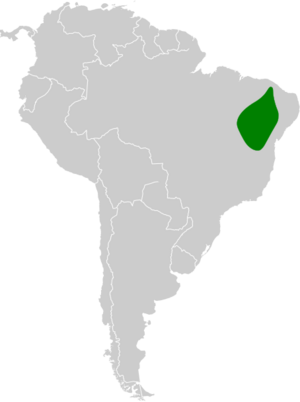Broad-tipped hermit facts for kids
Quick facts for kids Broad-tipped hermit |
|
|---|---|
 |
|
| Conservation status | |
| Scientific classification | |
| Genus: |
Anopetia
|
| Species: |
gounellei
|
 |
|
| Synonyms | |
|
Phaethornis gounellei |
|
The broad-tipped hermit (Anopetia gounellei) is a special type of hummingbird that lives only in Brazil. It's known for its unique beak!
Contents
What is a Broad-tipped Hermit?
A Tiny Bird with a Big Name
The broad-tipped hermit is a small bird from the Trochilidae family, which is the hummingbird family. It's called a "hermit" because it belongs to a group of hummingbirds known for living in dense forests and often feeding alone. This particular hermit is found only in Brazil, meaning it is endemic there.
Its Place in the Bird Family Tree
For a while, scientists thought the broad-tipped hermit belonged to a very large group of hummingbirds called Phaethornis. But now, they've given it its own special group, called Anopetia. This means it's the only species in that group! It doesn't have any different types or subspecies within its own kind.
What Does It Look Like?
Size and Colors
The broad-tipped hermit is a pretty small bird. It's about 11 to 12.6 centimeters (about 4 to 5 inches) long. That's roughly the length of a pen! It weighs only about 2.6 to 3.4 grams, which is less than a penny.
Its back is a shiny bronzy-green color. Its belly and chest are mostly light brownish or a warm, yellowish-brown color.
Special Markings
This hummingbird has a cool "mask" of black feathers around its eyes. Above its eyes, it has a white stripe, like a little eyebrow, called a supercilium. It also has a white stripe on its cheek, called a malar stripe. Its throat is dark brown with a bright orangey border.
The Broad Tip of Its Beak
The most interesting part of its name comes from its beak! The top part of its beak, called the maxilla, is wide and actually overlaps the bottom part, the mandible. This is different from many other birds.
Its tail feathers are also special. The two feathers in the very middle are longer than the others. All of its tail feathers have white tips, which helps it stand out. Both male and female broad-tipped hermits have beaks that curve in a similar way.
Where Does It Live?
Its Home in Brazil
The broad-tipped hermit lives in the northeastern part of Brazil. You can find it in an area that stretches from a state called Ceará in the north, down to western Bahia and northeastern Minas Gerais.
Its Favorite Places
This bird loves to live in places called caatinga. This is a type of dry forest in Brazil that can be a bit humid. It prefers areas with lots of dense plants and bushes under trees. But you might also see it in more open areas, like the cerrado, which is a type of savanna. It can live anywhere from close to the sea up to about 1,200 meters (about 3,900 feet) high in the mountains.
How Does It Behave?
Staying Put or Moving Around?
Scientists believe that broad-tipped hermits usually stay in one place. They don't travel far. However, sometimes they might make small moves depending on the season.
What Does It Eat?
The broad-tipped hermit is a "trap-line" feeder. This means it visits a regular path of flowering plants, almost like it's following a secret route! It drinks nectar from many different kinds of flowers. Besides nectar, it also eats tiny arthropods, which are small creatures like insects or spiders.
How Does It Raise Its Young?
We don't know everything about when broad-tipped hermits nest, but it seems to be from at least December to February. The few nests that have been found are shaped like cups. They are usually hung underneath a large leaf, keeping the eggs safe and hidden. A female broad-tipped hermit usually lays two eggs. Interestingly, male broad-tipped hermits have been seen helping to keep the eggs warm, which is called incubating. These birds might also gather in special places to find mates, which is called a lek.
What Does Its Song Sound Like?
The broad-tipped hermit has a unique song. It's described as a series of two notes that go up and down, like "si-lew." It repeats this sound over and over again. Sometimes, it might change its song to a longer sound like "suweesi."
Is It in Danger?
The IUCN (International Union for Conservation of Nature) has looked at the broad-tipped hermit and decided it is a species of "Least Concern." This means they are not worried about it becoming extinct right now. We don't know exactly how many of these birds there are, or if their numbers are going up or down.
Even though we don't have exact numbers, it's thought that this bird is not very common. However, people who study birds see it regularly. Also, the places where it lives, like the caatinga, are not currently facing major threats. This helps the broad-tipped hermit stay safe.


